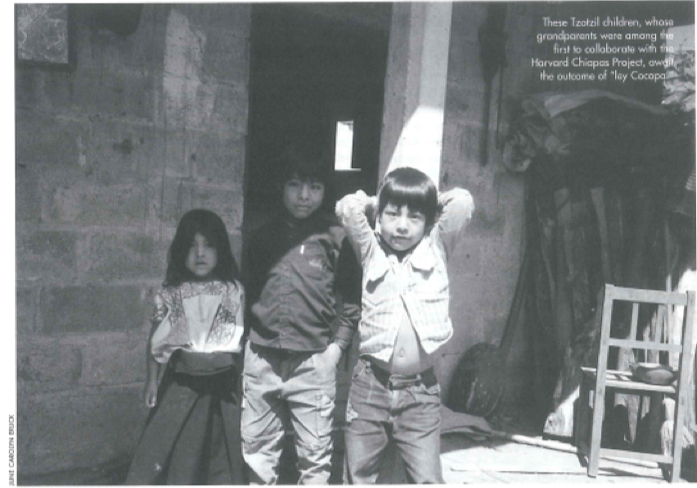Indigenous Law does not make Indigenous Right

If Mexico’s widely hailed democratic transition is to be successful, it must serve as a framework for the resolution of the social and political conflict that has pitted the Zapatista National Liberation Army (EZLN) against the Mexican government since the beginning of 1994. When Vicente Fox was elected president in July 2000, he declared that he would resolve the conflict, something his two predecessors had been unable to do, and as soon as he took power in December, he submitted a draft Indian Law to the Congress.
This bill, also known as ley Cocopa, has a curious history. It was drawn up by a legislative commission comprised of senators and deputies from all political parties represented in the congress on the basis of the San Andrés Accords, an agreement signed by the Zedillo administration and the Zapatistas in 1996. While the Zapatistas generally agreed with the bill, the PRI government did nothing about the proposal for four years. There was a flood of alternative bills submitted by PRI president Ernesto Zedillo, the PAN (Fox’s party), and the Ecological Party, but there was no congressional action. When President Fox dusted off the ley Cocopa and sent it to the congress, the Zapatistas believed that the spirit of the San Andrés Accords would be upheld and decided to stage their triumphal march in Mexico City to present their case (February-March 2001). After much wrangling, a handful of deputies and senators agreed to receive them. By that time a number of indigenous organizations, as well as numerous other sectors of the civil society, had declared their support for the bill. The public hoped that with the passage of this law, peace negotiations between the government and the Zapatistas would resume.
Between 1996 and 2000, the two principal actors in the conflict engaged in a silent standoff. The government accused the EZLN of intransigence and the EZLN blamed the government for breaking its word. The national mediation commission (CONAI), headed by Bishop Samuel Ruiz, was dissolved and other means of bringing the two sides together also failed. For instance, I became a member of the oversight commission of the San Andrés Accords (Comisión de Seguimiento y Verificación COSEVER), made up of representatives of each of the contenders and a number of independent experts. After the first meeting, when it was formally installed in San Cristóbal, the Commission was unable to meet again, because when invited, either the Zapatistas or the federal government were unwilling to take part. Being the chairman of a non-functioning commission is not particularly pleasant not so much because of the inactivity as the lingering sense of frustration at not being able to make a useful contribution to the peace process.
The new congress is quite different from previous legislatures. For the first time, the legislative branch is not subject to the whims and wishes of the executive. The new independence has resulted in more give-and-take among the legislators from different parties, negotiating issues and making and unmaking voting alliances. Still, the old PRI maintains a majority in the senate and a strong plurality in the chamber of deputies. Prospects for the passage of the bill, which both the PRI and the PAN rejected in previous years, was looking dim. President Fox surely knew this, and it is an open question whether he actually wanted the bill to be approved as it stood or expected the Congress to re-tailor it, as it did.
After a short debate, the Senate modified the ley Cocopa into a proposal for a constitutional amendment. Now, for the first time in Mexican history, an entirely new Article 2 of the Constitution would be devoted to the subject of indigenous peoples. However, the new amendment talked not about indigenous peoples but about communities, a modification that infuriated many. The senate passed the measure unanimously and a few days later the chamber of deputies approved it by a large majority (only the PRD and a few conscientious representatives voted against it). At least sixteen state legislatures are required to approve the amendment for it to become effective. By mid-June 2001 it seemed likely that this would happen.
The Zapatistas, the indigenous organizations, and many others in Mexico are not happy with the result, because they sense that the new text differs on essential points from the original Ley Cocopa and the San Andrés Accord. The EZLN has once again broken off contact with the government and the prospects for a resumption of peace talks have receded. The Zapatistas are weighing their options, which may take some time. Even some government officials have voiced their disappointment and concern. The PRD conceded that it made a mistake in voting for the bill in the Senate, but their abstention would not have made a difference, anyway. The indigenous movement has staged protests and declared its opposition to the new amendment, but its impact on the overall situation has so far been slight. People have asked President Fox to veto the bill, but as some scholars point out, a president has no power to veto a constitutional amendment, which is the sole prerogative of the legislative branch. If the amendment goes into effect, implementing legislation will have to be passed and some people see this as another chance to get back to the original spirit of the San Andrés Accords.
What is all the ruckus about?
The Mexican government is worried that recognizing indigenous peoples as subjects of law and rights (sujetos de derecho) would undermine the unity and sovereignty of the state. It therefore prefers to speak, as it always has, of communities (more localized units of administration). The Zapatistas, on the other hand, and with them numerous indigenous and popular organizations, insist that any legally recognized rights should go to the indigenous peoples, a concept which would still have to be defined carefully in the context of Mexico. The indigenous organizations feel that by denying Indians the status and dignity of peoples, the Mexican state would continue to keep them subordinate and fragmented in a haphazard assemblage of small villages, thus depriving them of the possibility of playing a major role in national politics.
The same argument holds for the concept of autonomy. The Zapatistas and the indigenous movement would like to see it legally enacted, whereas the government shies away from it, holding up the spectre of Balkanization. At best, the new amendment would recognize a degree of local autonomy within existing municipal structures. The Indians, on the other hand, would like to expand municipal limits into larger, viable regional units. Again, the concept is ambiguous and would require careful elaboration by the legislature and the judiciary. The proposed constitutional amendment would leave this to the states, whereas the Zapatistas would like the federal government to legislate directly. As the argument goes, at the state level local vested interests are better able to squash indigenous rights.
Much of the debate centers on land, territory, and resources. The San Andrés Accord foresaw the possibility of indigenous control over their homelands and local economic resources, which are increasingly subject to private economic interests. The new legislation rejects any reference to the collective management of resources and will protect the interests of third parties in accordance with existing legislation. In other words, it in no way threatens the large private landholding interests. This runs counter to long-standing demands of peasant and indigenous organizations for restoration of their traditional land-rights under the land reform legislation of the early twentieth century, done away with in the 1992 constitutional reform of the Salinas administration.
Another controversial issue is how the practice of customary law in indigenous communities (usos y costumbres) relates to both the administration of justice and the appointment of local authorities. Many indigenous communities claim that the power of the PRI in rural areas is based on its control of municipal functionaries which local state governments had appointed and removed at will for many decades. They insist on more local power of decision-making based on their traditional non-written codes of social control, customs, and mores. Again, some scholars argue that this would threaten the unity of the state and establish the basis for legal pluralism, which runs counter to the unitary conception of a national positive legal system. Their arguments have convinced politicians that usos y costumbres is bad for the Indians and would be bad for the country. Indians, however, think otherwise.
Somewhat less controversial is bilingual and intercultural education, a policy the federal government adopted some decades ago, but which has not received the national attention it deserves. Indians represent about 15% of Mexico’s total population and at least 56 different Indian languages are spoken in the country. The constitutional recognition of these languages would have wide ranging policy implications, and the implementation of a multicultural educational policy would be costly and complicated, particularly because so many Indian groups are now dispersed throughout the country (in northern border squatter settlements, large metropolitan areas, and small isolated mountain villages) as a result of migration. Especially because the decentralization of federal services has become normal practice, the constitutional amendment would leave the onus of this problem to local state governments.
Beyond the various technical and legal issues related to the textual variations between the San Andrés Accords, the ley Cocopa, and the proposed constitutional amendment, there are a few main questions: What kind of a nation will Mexico be? Will the indigenous peoples become full participants in the polity and the society? Is Mexican society willing to engage Indian peoples in a tolerant, mutually respectful, and constructive dialogue, or will Indians remain at the bottom of the heap, expecting no more than occasional scraps of welfare, continuing clientelism and an occasional patronizing and opportunistic nod from the entrenched power elites?
Official voices state that the constitutional amendment is a step in the right direction, helping to redress the historical injustices that Indians have suffered. The Zapatistas and the indigenous movement, on the contrary, feel that they have been short-changed once more and that the amendment, as approved, is only a smokescreen for business as usual, making any effective change even harder now that this stage of the legal process has concluded. While some may think that the adoption of the amendment will turn a page in Mexican history, allowing the country to move on to other things, others believe that it leaves the conflict unsolved and will make future peace negotiations if they were ever to take place even harder. At any rate, indigenous communities will not see any dramatic improvements in their situation in the near future. It remains to be seen how the Fox administration will deal with this problematique in the years to come. And sooner or later the Zapatistas and the Indian movement (they are not necessarily identical) will make their voices heard once again.
Fall 2001, Volume I, Number 1
Rodolfo Stavenhagen is a research professor at El Colegio de Mexico and was Robert F. Kennedy Visiting Professor in Latin American Studies in the Anthropology Department at Harvard University in 2000-2001. He has just been appointed special rapporteur of the UN Human Rights Commission on the rights and fundamental freedoms of indigenous people.
Related Articles
Editor’s Letter: Mexico in Transition
You are holding in your hands the first issue of ReVista, formerly known as DRCLAS NEWS.
Over the last couple of years, DRCLAS NEWS has examined different Latin American themes in depth.
The View from Los Angeles
In 1999, on returning home to LA after four years at Harvard and in the Boston area,I ascended to the city of Angels for the annual gala dinner of the premier civil rights firm: the Mexican American…
What’s New about the “New” Mexico
On July 2, 2000, Mexican voters brought to an end seven decades of one-party authoritarian rule. Just over a year later, Mexico continues to feel the repercussions of this momentous victory…




